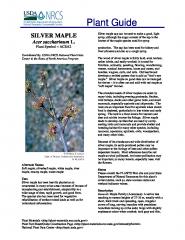Sometimes misspelt as Acer saccharinium. Bloom Color: Red.
Main Bloom Time: Early spring, Late spring, Mid spring. Form: Vase.
Acer saccharinum is a deciduous Tree growing to 30 m by 15 m at a fast rate.
It is hardy to zone 3. It is in flower from February to March, and the seeds ripen from April to June. The species is hermaphrodite and is pollinated by Wind.
Suitable for: light , medium and heavy soils and can grow in heavy clay soil. Suitable pH: acid, neutral and basic soils. It can grow in semi-shade or no shade. It prefers moist soil. The plant can tolerates strong winds but not maritime exposure.
It can tolerate atmospheric pollution.
Agroforestry Services: Crop shade Fodder: Bank Industrial Crop: Biomass Management: Coppice Management: Standard Staple Crop: Sugar
Landscape Uses:Erosion control, Firewood, Aggressive surface roots possible, Woodland garden. Of easy cultivation, it prefers a good moist well-drained soil but does well in much wetter soils than most member of the genus. Succeeds in most soils including chalk. Another report says that this species is liable to become chlorotic as a result of iron deficiency when it is grown on alkaline soils. Grows well in heavy clay soils. Prefers a moderately sunny position. Tolerates atmospheric pollution. Fairly wind-tolerant. The wood is brittle and branches are liable to break off the tree in high winds. Trees can tolerate short periods of flooding, but are very susceptible to fire. A very ornamental and fast growing tree, but it is short-lived, seldom surviving longer than 125 - 140 years. The tree has invasive roots and these often interfere with sewer pipes and drainage tiles around houses. The silver maple is a bad companion plant, inhibiting the growth of nearby plants. Special Features:Attracts birds, North American native, Naturalizing. Carbon farming - Cultivation: experimental. Management: standard, coppice. The plant is heat tolerant in zones 8 through 1. .
At this temperature, many plants begin to suffer physiological damage. Heat Zones range from 1 to 12 .
For example Heat Zone. 11-1 indicates that the plant is heat tolerant in zones 11 through 1.) For polyculture design as well as the above-ground architecture information on the habit and root pattern is also useful and given here if available. The plant growth habit is a standard with a non-suckering single trunk . The root pattern is flat with shallow roots forming a plate near the soil surface .
Habitatsusually in sandy soils. Trees are occasionally found in deep often submerged swamps.
HabitatsWoodland Garden Canopy
HabitatsWoodland Garden Canopy
Resources
Fact Sheet for Acer saccharinum

Plant Fact Sheet
Plant Materials
https://plants.usda.gov/factsheet/pdf/fs_acsa2.pdfFact Sheet for Acer saccharinum
Plant Fact Sheet/Guide Coordination Page
National Plant Data CenterFact Sheet for Acer saccharinum
Plant Fact Sheet
USDA NRCShttps://plants.usda.gov/factsheet/pdf/fs_acsa2.pdf
Plant Materials
Plant Fact Sheet/Guide Coordination Page
National Plant Data Center
SILVER MAPLE
Acer saccharinum L.
Plant Symbol = ACSA2Fact Sheet for Acer saccharinum
Plant Fact Sheet
USDA NRCShttps://plants.usda.gov/factsheet/pdf/fs_acsa2.pdf
Plant Materials
Plant Fact Sheet/Guide Coordination Page
National Plant Data Center
SILVER MAPLE
Acer saccharinum L.
Plant Symbol = ACSA2Plant Guide for Acer saccharinum

Plant Guide
Plant Materials
https://plants.usda.gov/plantguide/pdf/pg_acsa2.pdfPlant Guide for Acer saccharinum
Plant Fact Sheet/Guide Coordination Page
National Plant Data CenterPlant Guide for Acer saccharinum
Plant Guide
USDA NRCShttps://plants.usda.gov/plantguide/pdf/pg_acsa2.pdf
Plant Materials
Plant Fact Sheet/Guide Coordination Page
National Plant Data Center
SILVER MAPLE
Acer saccharinum L.
Plant Symbol = ACSA2Plant Guide for Acer saccharinum
Plant Guide
USDA NRCShttps://plants.usda.gov/plantguide/pdf/pg_acsa2.pdf
Plant Materials
Plant Fact Sheet/Guide Coordination Page
National Plant Data Center
SILVER MAPLE
Acer saccharinum L.
Plant Symbol = ACSA2
